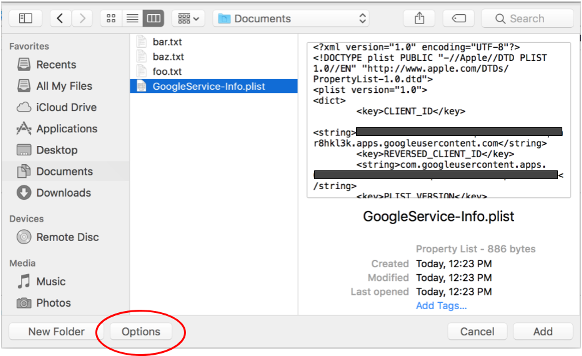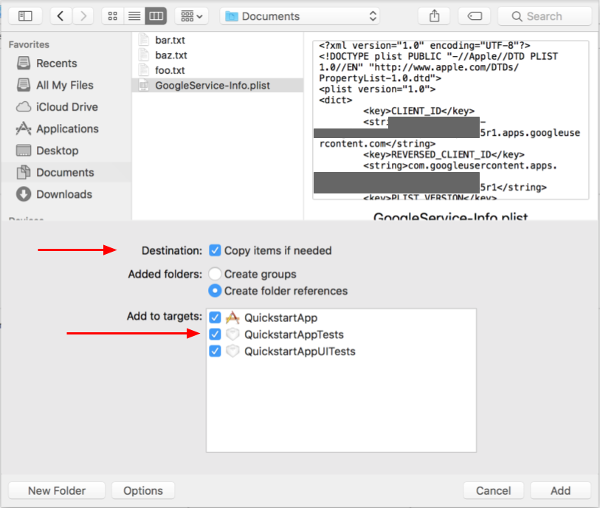本頁面說明的步驟,將引導您快速建立簡易的 iOS 應用程式,向 YouTube Data API 發出要求。本範例說明如何擷取 GoogleDevelopers YouTube 頻道的資料。程式碼也包含註解,說明如何修改查詢,以擷取目前使用者 YouTube 頻道的資料。
必要條件
如要執行這項快速入門導覽課程,您需要:
步驟 1:開啟 YouTube Data API
-
使用這個精靈在 Google Developers Console 中建立或選取專案,並自動啟用 API。依序點按「繼續」和「前往憑證」。
-
在「建立憑證」頁面中,按一下「取消」按鈕。
-
選取頁面頂端的「OAuth 同意畫面」分頁標籤。 選取「電子郵件地址」,輸入「產品名稱」 (如果尚未設定),然後按一下「儲存」按鈕。
-
選取「憑證」分頁,按一下「建立憑證」按鈕,然後選取「OAuth 用戶端 ID」。
- 選取應用程式類型「iOS」,輸入名稱「YouTube Data API Quickstart」,以及軟體包 ID
com.example.QuickstartApp,然後按一下「建立」按鈕。
步驟 2:準備工作區
- 開啟 Xcode 並建立新專案:
- 依序點選「File」>「New」>「Project」,選取「iOS」>「Application」>「Single View Application」範本,然後點選「Next」。
- 將「Product Name」(產品名稱) 設為「QuickstartApp」,「Organization Identifier」(機構 ID) 設為「com.example」,「Language」(語言) 設為
Objective-C。
在機構識別碼下方,您應該會看到與步驟 1.b 中輸入的 iOS 軟體包 ID (
com.example.QuickstartApp) 相符的軟體包 ID。 - 點選 [下一步]。
- 選取專案的目標目錄,然後按一下「建立」。
- 依序點選「File」>「Close Project」,關閉專案。
- 開啟終端機視窗,然後前往內含您剛建立的
QuickstartApp.xcodeproj檔案的目錄。 執行下列指令來建立 Podfile、安裝程式庫,並開啟產生的 Xcode 專案:
cat << EOF > Podfile && platform :ios, '8.0' target 'QuickstartApp' do pod 'GoogleAPIClientForREST/YouTube', '~> 1.2.1' pod 'Google/SignIn', '~> 3.0.3' end EOF pod install && open QuickstartApp.xcworkspace在 XCode 專案導覽器中,選取「QuickstartApp」專案節點。然後依序點選選單項目「File」>「Add files to "QuickstartApp"」。

找出先前下載的
GoogleService-Info.plist檔案並選取。 按一下「選項」按鈕。
在選項視窗中選取下列項目,然後按一下「新增」按鈕:
- 勾選「Copy items if needed」核取方塊。
- 檢查「新增至目標」部分列出的所有目標。

選取專案節點後,在「TARGETS」部分選取「QuickstartApp」,如下方兩張圖片所示:
按一下這個螢幕截圖中顯示的區域:

然後選取適當的目標:

選取「資訊」分頁標籤,然後展開「網址類型」部分。
按一下「+」按鈕,然後為反向用戶端 ID 新增網址架構。如要找出這個值,請開啟您在步驟 2.f 中選取的
GoogleService-Info.plist設定檔。找出 REVERSED_CLIENT_ID 鍵。複製該金鑰的值,然後貼到設定頁面的「URL Schemes」(網址架構) 方塊中。將其他欄位留空。重建專案:
- 按一下「Product」>「Clean Build Folder」 (同時按住 option 鍵)。
- 按一下「Product」>「Build」。
步驟 3:設定範例
將下列檔案的內容替換為提供的程式碼:#import <UIKit/UIKit.h> @import GoogleSignIn; @interface AppDelegate : UIResponder <UIApplicationDelegate> @property (strong, nonatomic) UIWindow *window; @end
#import "AppDelegate.h" @implementation AppDelegate - (BOOL)application:(UIApplication *)application didFinishLaunchingWithOptions:(NSDictionary *)launchOptions { // Initialize Google sign-in. [GIDSignIn sharedInstance].clientID = @"<YOUR_CLIENT_ID>"; return YES; } - (BOOL)application:(UIApplication *)application openURL:(NSURL *)url sourceApplication:(NSString *)sourceApplication annotation:(id)annotation { return [[GIDSignIn sharedInstance] handleURL:url sourceApplication:sourceApplication annotation:annotation]; } @end
#import <UIKit/UIKit.h> @import GoogleSignIn; #import <GTLRYouTube.h> @interface ViewController : UIViewController <GIDSignInDelegate, GIDSignInUIDelegate> @property (nonatomic, strong) IBOutlet GIDSignInButton *signInButton; @property (nonatomic, strong) UITextView *output; @property (nonatomic, strong) GTLRYouTubeService *service; @end
#import "ViewController.h" @implementation ViewController - (void)viewDidLoad { [super viewDidLoad]; // Configure Google Sign-in. GIDSignIn* signIn = [GIDSignIn sharedInstance]; signIn.delegate = self; signIn.uiDelegate = self; signIn.scopes = [NSArray arrayWithObjects:kGTLRAuthScopeYouTubeReadonly, nil]; [signIn signInSilently]; // Add the sign-in button. self.signInButton = [[GIDSignInButton alloc] init]; [self.view addSubview:self.signInButton]; // Create a UITextView to display output. self.output = [[UITextView alloc] initWithFrame:self.view.bounds]; self.output.editable = false; self.output.contentInset = UIEdgeInsetsMake(20.0, 0.0, 20.0, 0.0); self.output.autoresizingMask = UIViewAutoresizingFlexibleHeight | UIViewAutoresizingFlexibleWidth; self.output.hidden = true; [self.view addSubview:self.output]; // Initialize the service object. self.service = [[GTLRYouTubeService alloc] init]; } - (void)signIn:(GIDSignIn *)signIn didSignInForUser:(GIDGoogleUser *)user withError:(NSError *)error { if (error != nil) { [self showAlert:@"Authentication Error" message:error.localizedDescription]; self.service.authorizer = nil; } else { self.signInButton.hidden = true; self.output.hidden = false; self.service.authorizer = user.authentication.fetcherAuthorizer; [self fetchChannelResource]; } } // Construct a query and retrieve the channel resource for the GoogleDevelopers // YouTube channel. Display the channel title, description, and view count. - (void)fetchChannelResource { GTLRYouTubeQuery_ChannelsList *query = [GTLRYouTubeQuery_ChannelsList queryWithPart:@"snippet,statistics"]; query.identifier = @"UC_x5XG1OV2P6uZZ5FSM9Ttw"; // To retrieve data for the current user's channel, comment out the previous // line (query.identifier ...) and uncomment the next line (query.mine ...). // query.mine = true; [self.service executeQuery:query delegate:self didFinishSelector:@selector(displayResultWithTicket:finishedWithObject:error:)]; } // Process the response and display output - (void)displayResultWithTicket:(GTLRServiceTicket *)ticket finishedWithObject:(GTLRYouTube_ChannelListResponse *)channels error:(NSError *)error { if (error == nil) { NSMutableString *output = [[NSMutableString alloc] init]; if (channels.items.count > 0) { [output appendString:@"Channel information:\n"]; for (GTLRYouTube_Channel *channel in channels) { NSString *title = channel.snippet.title; NSString *description = channel.snippet.description; NSNumber *viewCount = channel.statistics.viewCount; [output appendFormat:@"Title: %@\nDescription: %@\nViewCount: %@\n", title, description, viewCount]; } } else { [output appendString:@"Channel not found."]; } self.output.text = output; } else { [self showAlert:@"Error" message:error.localizedDescription]; } } // Helper for showing an alert - (void)showAlert:(NSString *)title message:(NSString *)message { UIAlertController *alert = [UIAlertController alertControllerWithTitle:title message:message preferredStyle:UIAlertControllerStyleAlert]; UIAlertAction *ok = [UIAlertAction actionWithTitle:@"OK" style:UIAlertActionStyleDefault handler:^(UIAlertAction * action) { [alert dismissViewControllerAnimated:YES completion:nil]; }]; [alert addAction:ok]; [self presentViewController:alert animated:YES completion:nil]; } @end
步驟 4:執行範例
依序點選「Product」>「Scheme」>「QuickstartApp」,切換至 QuickstartApp 結構配置,然後使用裝置模擬器或已設定的裝置執行範例 (Cmd+R)。首次執行範例時,系統會提示您登入 Google 帳戶並授權存取權。
附註
- 授權資訊會儲存在鑰匙圈中,因此後續執行作業時,系統不會提示授權。
